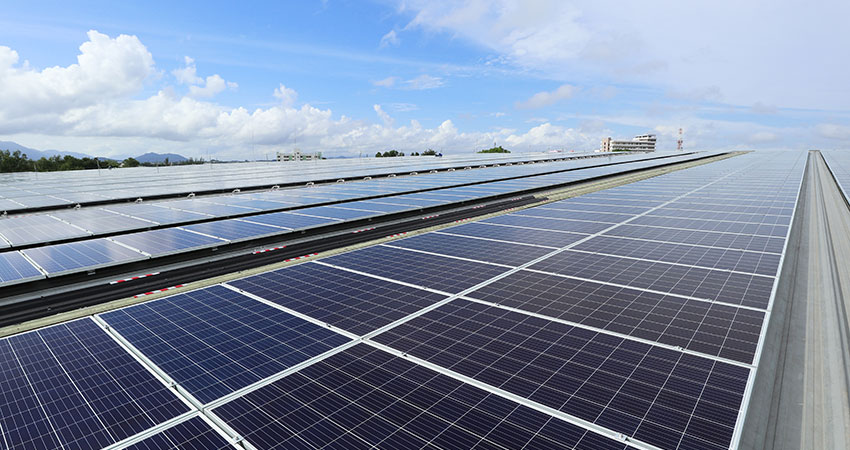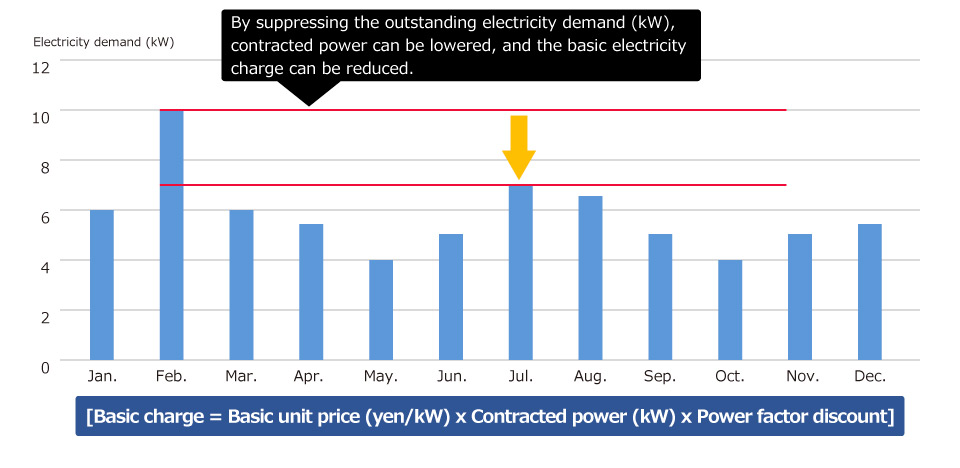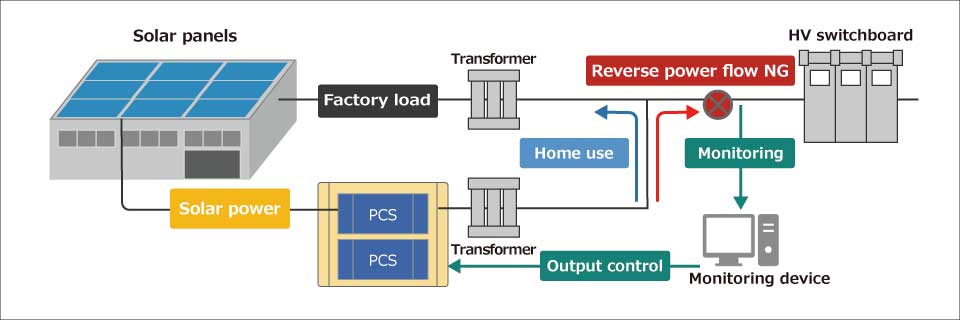Fuji Electric Product Column
Power conditioning system (PCS)

Power conditioning system (PCS)
A quick guide to captive solar power generation that reduces your electricity bills
Captive solar power generation, its types, and the background to its attractiveness today
Captive solar power generation is the use of power generated from solar panels installed on the rooftop of your factory or office building to save an electricity bill. Depending on how the power is used, there are two types: (1) full consumption and (2) surplus power sale.
In the full-consumption type, all power privately generated is consumed within your company. In the surplus-power-sale type, while part of your generated power is used in your company, the surplus power is sold to electric utility companies.
In practice, most companies that are engaged in self-generation do not externally sell their surplus power. To sell their surplus power to electric utility companies, they need to overcome obstacles such as being treated the same as an independent power producer that owns a solar power plant. In addition, the unit purchase price by electric utility companies has fallen steadily since the introduction of the feed-in tariff (FIT).
Therefore, most self-generating companies consume all the power themselves. When a factory temporarily suspends operation, such as during lunch breaks, surplus power is generated. Without a sales contract with an electric utility company, the self-generating company needs to limit the output of solar power generation to prevent backflow to the external grid. Using storage batteries to store surplus electricity is an option, but this is still not popular due to economic feasibility.
What makes power generation so attractive for businesses today? One reason is the growing global concern over environmental issues. Solar power generation does not use fossil fuels, thereby attracting attention as an effective means of reducing CO2 emission, a major goal.
Other renewable-energy sources, such as wind power and hydropower, still have restrictions on their locations. For instance, wind farms need to be built along the coast or on flat lands with strong winds constantly blowing. Hydro power plants require reservoirs such as rivers or lakes with substantial difference in height to generate electricity. Solar panels have lower hurdles in terms of geographical conditions. They can be installed anywhere as long as sunlight is available, resulting in their popularity.
Advantages of captive solar power generation
The biggest advantage of introducing captive solar power generation for a company is its direct effect on reducing electricity consumption. Electricity costs have been rising recently, while the cost of equipment for solar power generation has been declining. The self-generation of electricity and reduction of payments to electric utility companies can indirectly increase profits for a company. For a company with a profit margin of a few percent, the reduction in electricity bills may be effectively equal to or more than the profits from its main business.
Moreover, the adoption of captive solar power generation can reduce the basic electricity charge set by electric utility companies. The basic electricity charge is mainly determined by the unit price and contracted power (maximum demand). The contracted power here is determined based on the amount of electricity used during the time period when the highest amount of electricity was used in the last 12 months. By supplementing the electricity from solar power generation during the daytime, when the most electricity is used, a company can lower the peak power and thus reduce the contracted power, resulting in reducing the basic electricity charge.

In addition, the installation of solar power generation equipment may be eligible for government subsidy. There are two business models in captive solar power generation: (1) self-owned model, where equipment is installed as an asset of the company, and (2) power purchase agreement (PPA) model, where equipment is owned by a third party and installed free of charge, eliminating the initial cost, and the electricity obtained is purchased at a low price. Both models can be subsidized.
Another advantage is the preferential treatment system that is allowed to small and medium-sized companies certified by the Small and Medium-sized Enterprises Enhancement Act to be eligible. A company that installs new equipment such as solar power generation equipment can receive the merit of either immediate depreciation or tax credit. Immediate depreciation allows the company to record 100% of the acquisition cost in the first year. In the case of tax credit, the company can deduct either 7% or 10% of the acquisition cost (7% if the company’s capital exceeds 30 million yen and is not more than 100 million yen).
In addition to these tangible merits, the company may build a better reputation in society and among investors by stressing its effort in addressing environmental issues by using renewable energy. The effort may have strong appeal in terms of various initiatives, including the Sustainable Development Goals (SDGs) that all UN member countries should achieve by 2030, the Environmental, Social and Governance (ESG) investment that are made in companies that consider the environment and society, and the RE100 activities and initiative by companies that operate their business activities with 100% renewable electricity.
Within the company, the effort can also work as a part of a business continuity plan (BCP). Japan is a disaster-prone country. In the event of a disruption of grid power due to an earthquake or typhoon, emergency power supply from solar power generation can autonomously sustain a company’s operation. In addition, emergency power supply to the surrounding residents can substantially contribute to the local community.
Key considerations in adopting solar power generation
Despite the many advantages, we need to carefully consider the actual introduction of captive solar power generation. Key considerations are slightly different depending on whether it is the self-owned model or the PPA model, described in the previous section.
PPA operators can easily reduce electricity bills and CO2 emissions even if they do not own or maintain the equipment. However, the PPA contract needs to be individually examined, including the provision period and electricity charges. The handling of equipment after expiration of the contract period also varies by contract. Attention needs to be paid to additional costs that may be incurred when continuing to use the equipment.
In the PPA model, the operator bears no initial costs but assumes the risks if the expected power is not generated. For instance, due to a failure of the solar panels, the expected output may not be achieved. In the PPA model, the amount of electricity generated determines the amount of electricity cost that is saved. Therefore, reduced electricity generation may prolong the investment recovery period of the equipment.
A company that adopts the self-owned model needs to bear a significant initial cost. Therefore, it needs to carefully assess whether the investment is feasible. This assessment should also consider the maintenance requirements. When installing solar panels on the rooftop, additional reinforcement of the building, if it is not strong enough, may be needed.
The solar panels may suffer damage in a variety of ways, including by natural disasters, aging deterioration of the equipment itself, or crows dropping stones that crack the panels. It is hard to find out which part of the panel is damaged and where to repair it. In the case of ground installation of solar panels, weed control is needed. Fast-growing vegetation may shade the solar panels and hamper the power generation. Unattended operation of the equipment may necessitate the installation of monitoring equipment.
Components required for solar power generation
Finally, we will briefly go over the components required for the introduction of captive solar power generation.
First, a number of solar panels are needed that will sufficiently cover your power requirements. Solar panels generate direct current (DC), so a power conditioning system (PCS) is needed to convert it to alternating current (AC). The AC output power converted by the PCS is transformed by a transformer and supplied to the factory for consumption.

The transformer is also connected to a high-voltage switchboard that is connected to the grid of electric utility companies. The system is used to purchase electricity from an electric utility company to make up the shortfall in electricity requirement that is not covered by self-generated solar power. Without a surplus electricity sales contract with an electric utility company, reverse power flow (from PCS to grid) is prohibited. Therefore, the PCS also has a function to prevent reverse power flow.
To realize self-generation under the self-owned model, a PCS is a key component in addition to solar panels. Selecting an appropriate PCS is important. Fuji Electric Co., Ltd. offers PCSs with world-class efficiency. For more details, visit this page.


